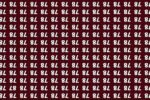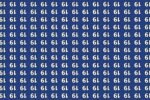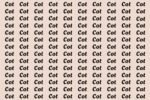Optical illusions have fascinated humans for centuries, captivating us with their ability to trick our brains into seeing things that aren’t there or not seeing things that are. From simple shapes that seem to shift or change, to complex images that reveal hidden secrets, optical illusions challenge our perception and test our ability to focus and think critically. One of the most intriguing types of illusions are those that require us to find hidden numbers or patterns within seemingly chaotic or repetitive backgrounds.
In today’s challenge, we’re going to test your powers of observation with a puzzle that features a sea of 59s, but with two particular numbers hidden among them: the inverted 65 and 59. Your mission, should you choose to accept it, is to find these two hidden numbers. Are you ready? Let’s dive in.
The Allure of Optical Illusions
Before we tackle the puzzle itself, let’s take a moment to consider what makes optical illusions so intriguing. At their core, optical illusions exploit the way our brains process visual information. Our eyes gather data from the world around us, and our brains interpret that data to create a coherent image. However, sometimes this process goes awry, leading us to see something that isn’t there or overlook something that is. This is the essence of an optical illusion.
The optical illusion we’re about to examine is particularly tricky because it requires a blend of visual acuity and patience. Our minds are wired to focus on patterns and repetition, so when faced with a uniform field of similar numbers, we tend to glaze over the details. It’s this very tendency that makes the challenge of finding the inverted 65 and 59 so much harder.
The Puzzle: A Sea of 59s
Imagine a large grid filled with the number 59. It’s a seemingly simple number, yet within this sea of 59s, two hidden numbers—65 and 59—are waiting to be discovered. But there’s a twist: one of the numbers is inverted, which adds an extra layer of difficulty to the puzzle. Your job is to scan the grid, searching for these two elusive numbers.
In optical illusions like this, the key is to train your focus. Rather than scanning the image haphazardly, it’s important to slow down and look for any discrepancies. You might be able to spot the numbers based on their unique shape or orientation, or perhaps the difference will be more subtle—an irregularity in spacing, a misalignment, or even a slight distortion in the pattern.
How to Tackle the Optical Illusion
The first step in solving any optical illusion is to stay calm and focused. If you approach the puzzle with a clear mind, you’ll have a better chance of spotting the hidden numbers. Begin by familiarizing yourself with the grid. Take a moment to study the number 59. Get to know its shape, its size, and its position in the grid. This will make it easier for you to spot any variations or inconsistencies.
Next, start scanning the grid systematically. It’s easy to get lost in the maze of numbers, so try to break the grid into smaller sections. Move row by row or column by column. When you focus on one small part of the grid at a time, it’s easier to spot the odd number out.
The inverted 65 might be the trickiest to find, especially because it’s flipped upside down. Look for a number that seems out of place in terms of its orientation. It might not align perfectly with the other 59s, or it could appear as a distorted shape. The key is to keep your eyes peeled and to think outside the box.
The Hidden 65: What to Look For
Let’s focus on the first number you need to find: the inverted 65. This number has been rotated 180 degrees, so it will look like a backwards 65 when viewed from the grid. The inversion is subtle, but if you pay close attention to the placement of the digits, you’ll start to see a number that doesn’t match the others.
When you spot the inverted 65, it may appear in a slightly different alignment than the rest of the numbers. The digits may be flipped in a way that causes the visual flow to feel interrupted. Keep an eye out for any shifts in the standard grid format. The number might be positioned differently, or the characters could appear as though they’ve been rotated or stretched. This is the magic of the optical illusion: the flipped 65 will seem like it belongs there, but it doesn’t quite fit.
Finding the Hidden 59
Now, let’s move on to the second number hidden in the grid: the regular 59. While this number is not inverted, it’s still concealed within the larger grid. Unlike the other 59s, this particular one might stand out due to its placement or alignment. It could be offset in a way that makes it easier to spot, or it could be placed in a position that’s slightly different from the others. Perhaps there’s a subtle break in the pattern that reveals the number.
Sometimes, our brains are trained to overlook familiar patterns. When faced with repetition, we tend to zone out and assume that everything looks the same. But the trick to spotting the hidden 59 is to challenge that assumption. Instead of assuming everything is identical, look for small variations. The 59 might be in a different row, a different column, or it could be part of a repeating cluster that breaks the usual rhythm.
The Reward of Finding the Hidden Numbers
So, how did you do? Were you able to find the inverted 65 and the hidden 59? Optical illusions like this one are more than just puzzles—they’re a workout for your brain. Solving them requires focus, patience, and the ability to break free from the automatic patterns your mind wants to follow.
The satisfaction of solving an optical illusion is a rewarding experience. When you spot the hidden numbers, you’ll feel a sense of accomplishment. It’s the result of using your mind in a new way, honing your attention to detail, and training your brain to see things differently.
The Science Behind Optical Illusions
You may be wondering why optical illusions work the way they do. What’s happening in our brains when we experience them? The science behind optical illusions is rooted in the way our visual system processes information.
When we look at an image, light enters our eyes and is sent to the brain for interpretation. Our brains then construct an image based on the data they receive, often making assumptions or “filling in gaps” to create a complete picture. In some cases, this process leads to errors—such as when the brain fills in a blank space with the wrong information, creating the illusion of a pattern or shape that isn’t actually there.
In the case of our optical illusion challenge, the brain is tricked into overlooking certain elements because of the repetitive nature of the grid. It’s a simple yet powerful demonstration of how our brains can sometimes be misled by our own expectations and assumptions.
Conclusion
Optical illusions are a fascinating and fun way to challenge your mind. Whether you’re trying to find hidden numbers, spot hidden shapes, or unravel complex visual patterns, these illusions offer an exciting way to test your powers of perception. The challenge of finding the inverted 65 and hidden 59 among the sea of 59s is just one example of how optical illusions can play with our visual senses and keep us engaged.
So, the next time you find yourself staring at a seemingly impossible puzzle, take a deep breath and approach it with patience and focus. Who knows? You might just uncover a hidden world of illusions waiting to be discovered.




